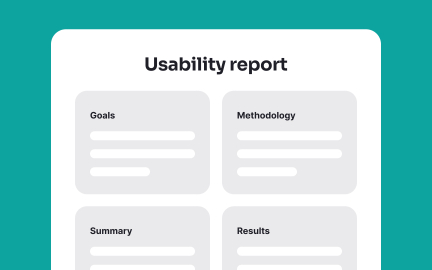Usability Heuristics
Usability heuristics are general design principles that guide the evaluation of interfaces, helping identify usability issues and improve user experience.

TL;DR
- General principles for evaluating usability.
- Introduced by Jakob Nielsen in 1994.
- Includes 10 widely adopted heuristics.
- Helps teams identify and fix design issues.
Definition
Usability heuristics are broad principles of interface design that serve as a framework for evaluating product usability and identifying potential problems in user interfaces.
Detailed Overview
Usability heuristics provide a foundation for evaluating digital products without needing fully developed user testing. First proposed by Jakob Nielsen, the 10 heuristics remain some of the most widely used guidelines in UX practice. They help teams uncover usability problems early, saving time and cost before release.
A frequent question is what the heuristics actually are. The classic set includes principles like visibility of system status, match between system and the real world, user control and freedom, consistency, error prevention, recognition over recall, flexibility, aesthetic minimalism, error recovery, and help/documentation. Each highlights a fundamental aspect of effective design.
Another common query is how heuristics are applied in practice. Teams often conduct heuristic evaluations, where usability experts review interfaces against these principles. For example, if a form lacks clear error messages, it violates the principle of error prevention and recovery. This method is cost-effective and provides actionable feedback even without large-scale user testing.
Teams also ask how heuristics differ from rules or standards. Heuristics are flexible guidelines, not rigid rules. They encourage critical thinking rather than dictating exact solutions. This adaptability makes them applicable across industries and platforms, from mobile apps to enterprise systems.
Accessibility often comes up in relation to heuristics. While accessibility is not a dedicated heuristic, many principles support it indirectly. For example, ensuring visibility of system status overlaps with providing screen reader feedback. Applying heuristics alongside accessibility guidelines creates more inclusive experiences.
Finally, usability heuristics are valuable for collaboration. By giving designers, developers, and product managers a shared vocabulary, they make usability discussions clearer and more structured. This shared framework strengthens design culture and keeps usability front of mind during development.
Learn more about this in the What are Usability Heuristics Exercise, taken from the Usability Heuristics Lesson, a part of the UX Research Course.
They were developed by Jakob Nielsen, a usability expert, in the 1990s. His 10 heuristics remain a cornerstone of UX practice today.
The framework is widely used across industries for product evaluation.
They include visibility of system status, match with the real world, user control, consistency, error prevention, recognition over recall, flexibility, minimalist design, error recovery, and documentation.
Each principle addresses a fundamental aspect of usability.
Experts review an interface against the heuristics, documenting issues and opportunities. This method identifies problems quickly without needing large-scale user tests.
It is often used in early design stages to save time and cost.
Not exactly. Heuristics focus on general usability principles, while accessibility guidelines address specific user needs like screen reader compatibility.
Together, they create more inclusive and effective products.
Despite changes in technology, the principles remain timeless because they reflect human cognition and behavior. They adapt easily across devices, platforms, and contexts.
This makes them a durable framework for evaluating usability.
Recommended resources
Courses

Color Psychology

UX Writing

UX Research
Lessons

10 Usability Heuristics by Jakob Nielsen

Usability Heuristics















